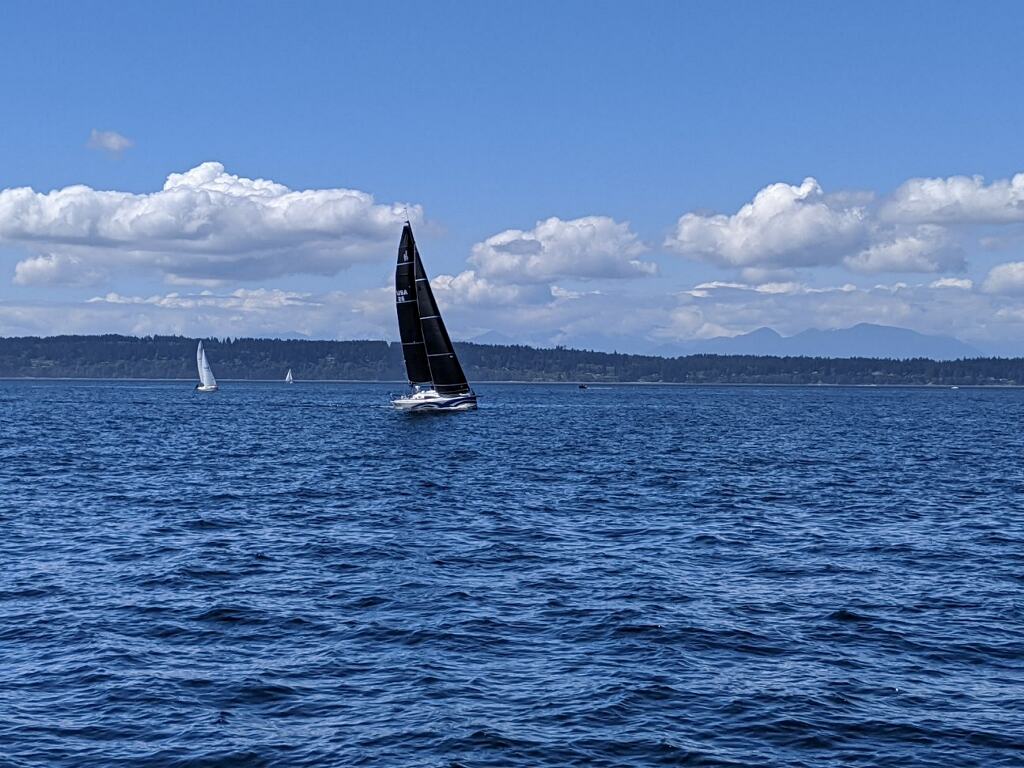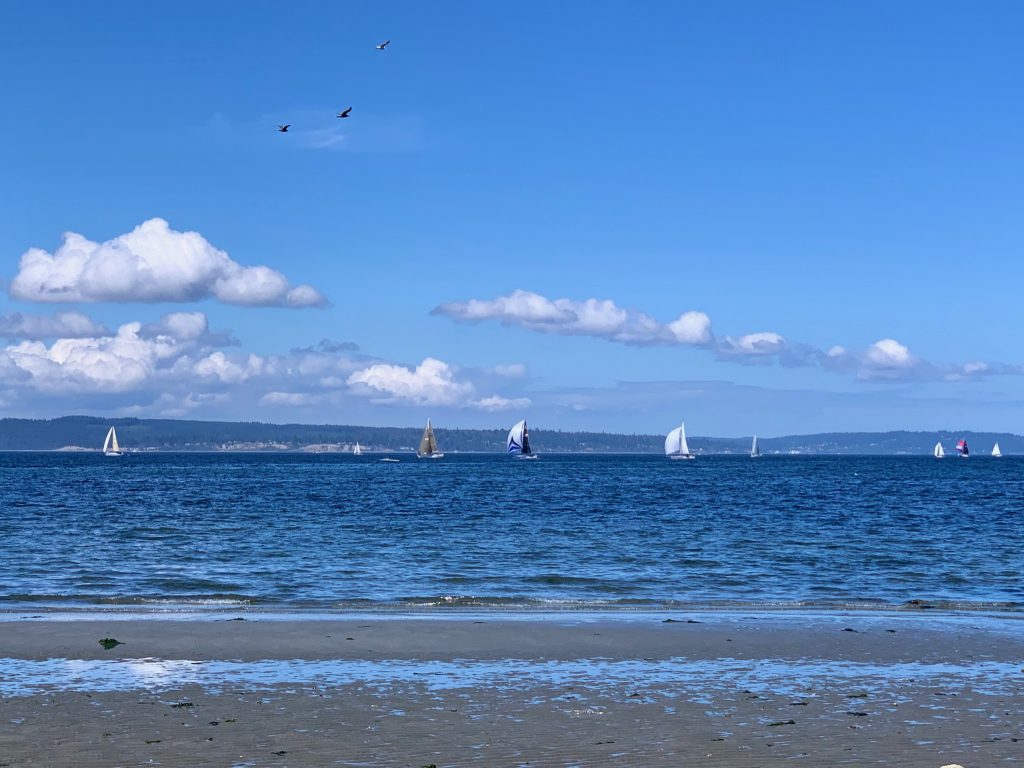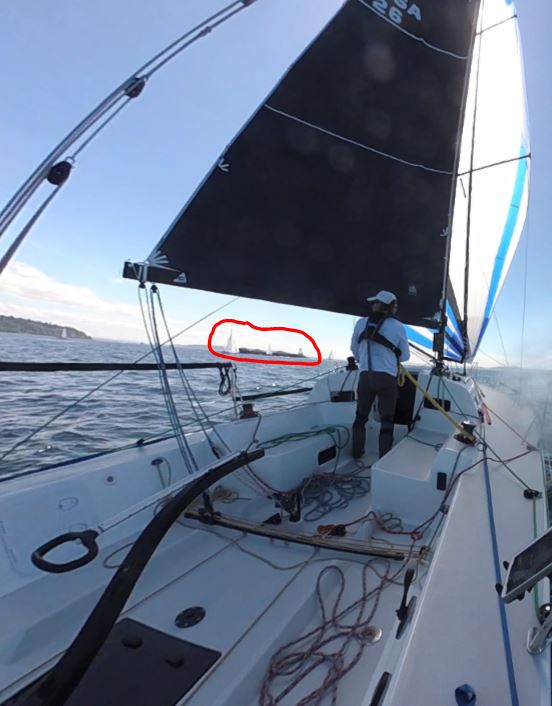

I raced Dragonfly (my prior boat, a 1969 Columbia 26 Mk II) singlehanded last season, but always in the non-flying sails division. She was rigged for an symmetric kite, but had no pole and no spinnaker. I became pretty expert doing wing-on-wing, but as all sailors know there’s a big difference between wing-on-winging a main and genoa and flying a spinnaker.
When STYC confirmed their annual singlehanded race was a go, I thought a lot about whether to enter One Life in the non-flying sails or the flying sails class. I’ve never launched, sailed, gybed, or dropped a spinnaker by myself, after all. I’ve never done much foredeck, in fact, so it’s all pretty much new to me. I entered the flying sails class anyway, figuring even if I didn’t want to fly the kite I’d still be racing.
36 boats signed up for the race, which is conducted as a pursuit start. Boats with the highest PHRF-NW ratings leave the line first, spaced out according to the projected time to complete the course. In theory, this means everyone would finish at the same time.
One Life was the 4th-to-last boat across the line, nearly an hour after the first boat started. Twenty-eight boats started, which meant I would need to pass 24 boats and stay ahead of 3 more to win — all in a 10.74nm course.
As I’ve noted previously, I have a history of screwing up the starts in these things. So, Kris and I went out Friday afternoon to ping the starting line with the Garmin instruments. I figured if I had an instrument telling me time to line and time to burn, I’d be less likely to screw things up.
Yeah, not so much.
Saturday dawned windless, with forecasts ranging from a south-southeasterly to norther-northeasterly wind, with literally everything in between. The wind filled in at 5-7 at the start for the first boat, thankfully from the north, which meant only one hoist and douse.
As boats got off the line, I was watching their tactical decisions closely. I waited until about 15 minutes before my start to get the main up, and about 8 minutes to get the jib out. Having tired myself out before the start in prior races by putting everything up too early, I didn’t want to make the same msitake here.
I was setting up pretty good for the start, but courtesy demanded I give the three J/105s starting ~3 minutes ahead of me some room. I ended up having to make a couple of moves I didn’t really want to do, and wasn’t where I wanted to be for my start. I ended up crossing the line about a minute late, laughing my ass off that even a few thousand dollars worth of electronics can’t seem to help me get my act together on these solo pursuit starts.
As it turns out, it was the best thing that could have happened. By the time I got my head out of the boat, I noticed my friend and excellent sailor Eric Finn in ‘O‘ was heading outside, instead of the bang-the-beach move we are all used to doing. I thought this was the right move after watching all the prior starters and seeing a pretty strong wind line outside.
As it turns out, after watching Skipper Jenn’s fun video (great soundtrack!) Eric actually did head inside after the start. I just didn’t see it because I was fooling around trying to miss J/105s and starting late…
I kept going out, keeping a close eye on the relative heel and speed of the boats farther ahead — both inside and out. 2/3rds of the fleet went way outside to catch the wind line. The other third hugged the beach.
The J/105 in front of me (Peer Gynt, I think) tacked short of a big glassy spot on the water — despite the fact the wind line was within 10-15 boat lengths of the other side. This was a smart move, honestly, as it was a bet the wind line would come down on top of us without having to go across a windless stretch and get it.
I thought otherwise, as it looked like the glassy patch was a current effect to me. Plus, I figured if it was as bad as it looked wind-wise, I could tack out and still be OK.
It turns out it was not only a current effect, but a really odd vortex of wind with a huge lift. I was doing almost a knot extra with a current push, plus receiving what had to be 30 degrees of lift. At one point, I was on a crossing heading with a boat not 300 yards to the inside of me — and we were both on starboard tack!
The wind line kept migrating south, as expected. When it came in, it was a huge header — which made sense looking at all the other boats. I kept with it to make sure it was actually here, then tacked when the wind went from 5 to 7 knots.
It was the one and only tack I needed headed to the windward buoy.

Fred the autopilot was working great, which gave me lots of time to get my head out of the boat. The wind started working around, so I was actually a little overstood to the mark — though not as much as most of the fleet, some of whom had to sail back to the mark. This allowed me to loosen my sails some and gain speed over some of the boats working the inside line, while helping to put some of the boats to the windward side of me on my hip and in my gas.
The rounding was pretty uneventful. I planned to round and sail as far as I needed to out to the east to get plenty of room to hoist the kite. As it turned out, I had plenty of room pretty quickly. I got Fred on (mostly) the right heading, prayed for no abrupt windshifts, and hoisted the kite.
It went pretty well, and I was shortly making my way off towards the leeward mark on a really good angle. Quick looks around showed most of the other boats nearby were either from the non-flying class or were just starting to get their kites up.
The breeze held a steady angle, so Fred was easily able to handle the tiller in hold heading mode. (FWIW, I do not think the wind hold mode is safe downwind as waves tend to make Fred overcorrect, risking an unplanned gybe.) An occasional tweak with the remote I was wearing around my neck and an ease or grind on the spinnaker and we settled in pretty quickly.
I took time to clean up the cockpit and to get my head out of the boat to see what was what. I noticed I rigged the spinnaker for an outside gybe (oops), so a quick trip up to the bow (tethers and jacklines are required, don’t worry) fixed that.
I took the time the night before to plot the course on my tablet, which conveniently draws a straight line from the windward to leeward mark. I was exactly on that line with a decent — though deep — angle. More importantly, I had a largely clear lane ahead of me with no boats posing immediate problems.
Peer Gynt rounded right behind me and cut the corner on the mark sharper than I did. He was coming up on the inside on a hotter angle, looking to perhaps sail over the top of me. While I didn’t particularly want to leave my perfect line, I also wasn’t going to let that happen. We, fortunately, didn’t get into a huge battle — possibly because there was some traffic outside he would have had to navigate — and he settled in on a slightly deeper course a few boatlengths off my hip.
I didn’t really realize, in retrospect, how many boats I was passing along the run to the windward mark. I was focused on the path ahead and any boats close behind. While the jousting with Peer Gynt had me a little farther above my line than I planned, given I was expecting the wind to clock a little more eastward the closer we got to the West Point buoy, I was still in good shape.

Fred was doing a good job, allowing me to play with the tack line (the A2, if you remember from the last blog, likes a little more tack out than you’d expect) and the trim. It also allowed me to rest some and walk through the douse in my head.
It was clear I was going to get to the leeward mark without a gybe, so about 2/3rds of the way to West Point I started prepping for a letterbox. I was standing there thinking of whether it it made sense to bring the lazy sheet around and through super early, when I picked up out in the distance…
The Dreaded Gravel Barge
There is a gravel mine on one of the islands. They deliver the gravel to the local cement makers via this big barge through the locks and to Lake Washington. Anyone who has sailed as much on Lake Union as I have knows to stay clear of this thing. They never throttle down and assume everyone will just get out of their way. Given they are commercial traffic, they have right of way in the entire area from where they depart to where they dock — that means sailboats have to get out of the way, too.
Most commercial traffic would have slowed, picked a gap, and gone through. Not this thing. A bunch of the fleet gybed back inside, figuring the barge would take a ‘normal’ route into the Ship Canal for commercial traffic — which has them line up directly outside the channel and go in from there.
Having watched this thing cut every marker as close as possible for the 2+ years I sailed on Lake Union, and not care who was in front of them, I bet the other way. I heated up, figuring he’d come in right at the West Point buoy.

I was right, as you can see in the picture above.
This, however, meant I needed to gybe to get to the mark. I used the heading hold and manually pushed Fred to do the gybe in 10-degree increments. It was slow, almost too slow, but I managed it.
The only problem was I was now on a completely different side than I expected the douse. I took a few deep breaths, re-visualized, and went for it.
(Here is my mental list, what did I miss?)
Go deep
Grab the lazy and start pulling
Blow the tack
Gather
Blow the halyard
Stuff down the companionway like a demon
After I quit stepping on things (foot cleat!), it went pretty well for my very first solo douse — except, as you’ll notice in the video and in my mental list above, I forgot to unfurl the jib!
I ended up a several boat lengths beyond the mark, but that was not too terrible given the wind direction. It did allow J/80 Underdog to get in underneath me (nice job, Lek!) as well as Peer Gynt. As it turned out, these were the only two boats to pass me all day (though I did pass them back).
I tacked outside shortly thereafter, because I have a terrible, miserable, very bad experience with a wind hole outside of the Ship Canal. After much mucking around to get the sails set, I was on my way back to the finish line.
I saw Dave in Aquavit tack, and figured that was a pretty damn good line since he is such a good sailor and an expert current reader. But after sailing right over the top of him nearly within touching distance in a weeknight race, I wasn’t going to do the same thing to him this time. Good choice, as the extra height really helped.
The autopilot remote chose this moment to become un-synchronized, so it was a messy manual tack. After I got that all straightened out, I grabbed the binoculars to make sure I was headed to the right place. Aquavit actually came up across my line to windward, so I ended up passing him to leeward.
At this point it was a drag race between me — overstood just a touch — and most of the rest of the fleet who ended up going inside. I was happy to take that bet, because I figured most of the boats would need to take at least 2 tacks to the line where I would need none.
As we got closer, I started to see adverse wind shifts. Instead of crossing right at the pin, I was getting headed towards the middle of the line. More Jubilee (J/105) was making her way up the breakwater, and I was worried we’d end up at the same place on the line with me on port and him on starboard.
I got a little reprieve from the wind gods, though, and crossed the line reasonably close to the pin. More Jubilee caught the mother of all lifts right at the breakwater and had the nerves of steel to sail right along it for the longest time. In fact, he never tacked! I included this bit on the video, if only because the lift he was getting inside is simply remarkable.
After two hours of racing, I beat him across by less than 30 seconds.
I furled the jib and fell off to clear the finish line for the other boats. I was tired, but happy, figuring I finished in the top third of the fleet. I stayed on the boat, didn’t break anything, and had a lot of fun doing it.
Another One Life Three Laws success!
Kris was on hand to help me dock. We got the boat put away, ate some lunch, and then I puttered around for a while on the boat. I got home, showered, and then snuck a peek at the STYC website to see if the results were posted yet.
Wait, what? I was second in class?!?
Holy shit! I was third overall ?!?!
(Remember when I said I had no idea how many boats I was passing?)
It was pretty much a perfect day for so many ‘firsts’ for me. The winds were light enough to make handling the kite easy, a beautifully sunny day, and a great group of competitors. And to come out third overall, well, wow.
I do love this boat.
I remembered to turn the video on for this race, so I have a visual record of the hoist, gybe, douse, and the last run to the finish. Lots of good lessons from watching this video for me, perhaps you can also learn from what I did right and wrong. (There was some condensation in the lens, in case you’re wondering about the cloudy bit dead center in the video.)
